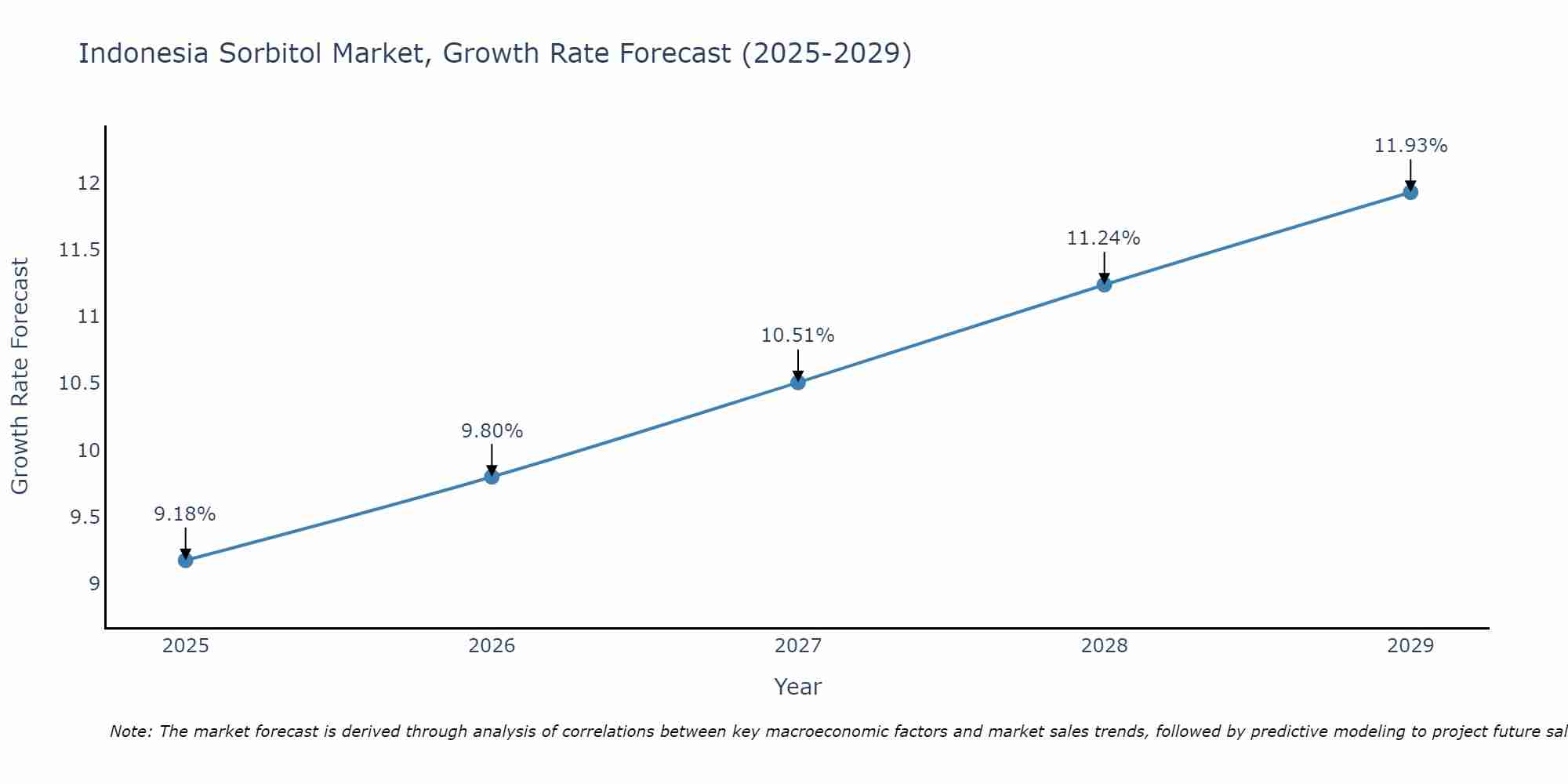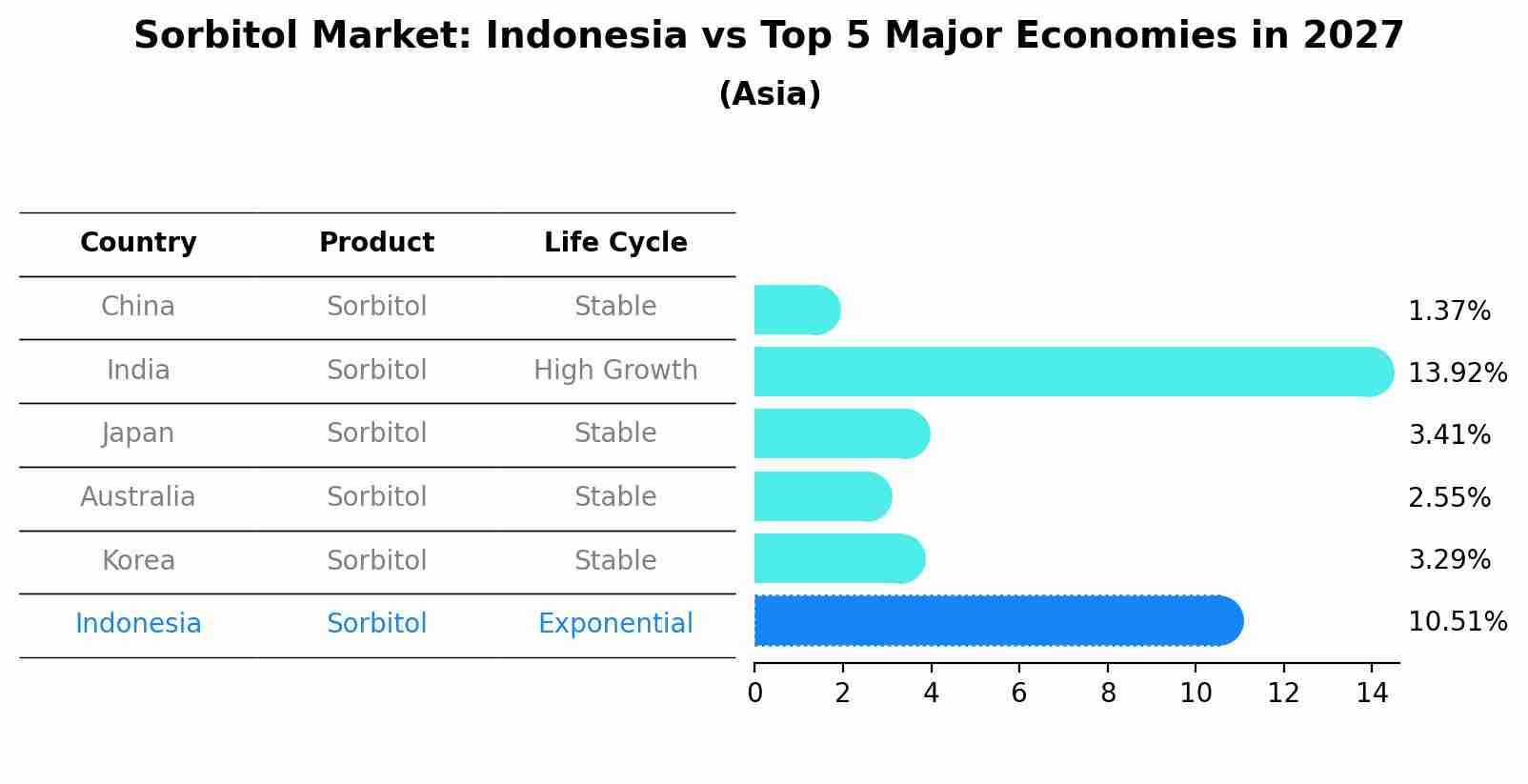Indonesia Sorbitol Market (2025-2031) Outlook | Revenue, Industry, Analysis, Size, Growth, Share, Value, Forecast, Companies & Trends
| Product Code: ETC089987 | Publication Date: Jul 2023 | Updated Date: Apr 2025 | Product Type: Report | |
| Publisher: 6Wresearch | No. of Pages: 70 | No. of Figures: 35 | No. of Tables: 5 | |
Indonesia Sorbitol Market Size Growth Rate
The Indonesia Sorbitol Market is likely to experience consistent growth rate gains over the period 2025 to 2029. From 9.18% in 2025, the growth rate steadily ascends to 11.93% in 2029.

Sorbitol Market: Indonesia vs Top 5 Major Economies in 2027 (Asia)
By 2027, the Sorbitol market in Indonesia is anticipated to reach a growth rate of 10.51%, as part of an increasingly competitive Asia region, where China remains at the forefront, supported by India, Japan, Australia and South Korea, driving innovations and market adoption across sectors.

Indonesia Sorbitol MarketSynopsis
Indonesia is the largest producer and consumer of sorbitol in Southeast Asia, with a production capacity of over 80,000 metric tons per year. Sorbitol is produced from glucose syrups mainly derived from cassava starch. It has numerous applications such as food and beverage sweetener, humectant for pharmaceuticals & cosmetics, toothpaste thickener etc. Indonesia growing demand for foodstuff ingredients like sweeteners drives the market growth here.
Market Trends
The increasing demand for low-calorie food items owing to growing health consciousness among people has been a major factor driving the Indonesia sorbitol market growth recently. Moreover, the rising usage of sugar-free items in various products such as confectionery items and beverages has significantly contributed to its use here. Additionally, factors like the government initiatives towards promoting healthy lifestyles have further stimulated its consumption in this region. Also due to being an economical substitute of sucrose or other natural sweeteners it is adopted by many manufacturers which will lead to increased use in future years too.
Market Drivers
Growing urbanization paired with changing dietary habits are some key drivers leading to higher consumption of processed foods that require artificial sweetening agents like sorbital causing an upsurge in Indonesia sorbitol market size. The high availability of raw materials used for producing these products makes them easily accessible at lower costs than synthetic ones resulting in their widespread adoption by end users across industries here.. Increasing expenditure on personal care also boosts its application potential as it finds usage mostly here as well adding fuel to its already existing trend upwards.
COVID-19 Impact on the Market
The outbreak of COVID-19 had a temporary negative effect on all industries including those related directly/indirectly with sorbital production & sales due industrial shutdowns & reduced supply chain activities? This led to decreased sales opportunities during 2025 but 2025 seems promising since most restrictions are now lifted & things are slowly getting back on track creating more room for business expansion.. So though initially there was decline evident it looks likely that soon enough we shall see positive effects being brought about again because markets usually bounce back after any crisis situation passes eventually paving way for new avenues ahead?
Challenges of the Market
Limited availability of raw materials for sorbitol production in Indonesia. High cost of imported raw materials due to import duties and taxes which increase the overall production costs. Lack of infrastructure and technology to produce high-quality sorbitol in Indonesia, resulting low marketability of local products compared with imported ones from other countries such as China, India, etc. Low domestic demand as most applications are limited to food industry while industrial demand is still relatively small compared with other countries in the region like Thailand or Vietnam due to lack of investment and awareness about the product?s potential uses by local consumers & manufacturers alike.
Industry Key Players
Indofarma, Sumber Agung Group, Wilmar International, Bintan Food Industry
Key Highlights of the Report:
- Indonesia Sorbitol Market Outlook
- Market Size of Indonesia Sorbitol Market, 2024
- Forecast of Indonesia Sorbitol Market, 2031
- Historical Data and Forecast of Indonesia Sorbitol Revenues & Volume for the Period 2021-2031
- Indonesia Sorbitol Market Trend Evolution
- Indonesia Sorbitol Market Drivers and Challenges
- Indonesia Sorbitol Price Trends
- Indonesia Sorbitol Porter's Five Forces
- Indonesia Sorbitol Industry Life Cycle
- Historical Data and Forecast of Indonesia Sorbitol Market Revenues & Volume By Product Type for the Period 2021-2031
- Historical Data and Forecast of Indonesia Sorbitol Market Revenues & Volume By Liquid/Syrup Sorbitol for the Period 2021-2031
- Historical Data and Forecast of Indonesia Sorbitol Market Revenues & Volume By Crystal/Powder Sorbitol for the Period 2021-2031
- Historical Data and Forecast of Indonesia Sorbitol Market Revenues & Volume By Application for the Period 2021-2031
- Historical Data and Forecast of Indonesia Sorbitol Market Revenues & Volume By Cosmetics & Personal Care for the Period 2021-2031
- Historical Data and Forecast of Indonesia Sorbitol Market Revenues & Volume By Food & Beverage for the Period 2021-2031
- Historical Data and Forecast of Indonesia Sorbitol Market Revenues & Volume By Pharmaceuticals for the Period 2021-2031
- Historical Data and Forecast of Indonesia Sorbitol Market Revenues & Volume By Creams and emulsions for the Period 2021-2031
- Historical Data and Forecast of Indonesia Sorbitol Market Revenues & Volume By Medicated confectionery for the Period 2021-2031
- Historical Data and Forecast of Indonesia Sorbitol Market Revenues & Volume By Chemical for the Period 2021-2031
- Historical Data and Forecast of Indonesia Sorbitol Market Revenues & Volume By Other Industries for the Period 2021-2031
- Indonesia Sorbitol Import Export Trade Statistics
- Market Opportunity Assessment By Product Type
- Market Opportunity Assessment By Application
- Indonesia Sorbitol Top Companies Market Share
- Indonesia Sorbitol Competitive Benchmarking By Technical and Operational Parameters
- Indonesia Sorbitol Company Profiles
- Indonesia Sorbitol Key Strategic Recommendations
Frequently Asked Questions About the Market Study (FAQs):
- Single User License$ 1,995
- Department License$ 2,400
- Site License$ 3,120
- Global License$ 3,795
Search
Related Reports
- Portugal Electronic Document Management Market (2025-2031) | Strategy, Consumer Insights, Analysis, Investment Trends, Opportunities, Growth, Size, Share, Industry, Revenue, Segments, Value, Segmentation, Supply, Forecast, Restraints, Outlook, Competition, Drivers, Trends, Demand, Pricing Analysis, Competitive, Strategic Insights, Companies, Challenges
- France Electronic Document Management Market (2025-2031) | Strategy, Consumer Insights, Analysis, Investment Trends, Opportunities, Growth, Size, Share, Industry, Revenue, Segments, Value, Segmentation, Supply, Forecast, Restraints, Outlook, Competition, Drivers, Trends, Demand, Pricing Analysis, Competitive, Strategic Insights, Companies, Challenges
- Portugal Occupational Health & Safety Services Market (2025-2031) | Strategy, Consumer Insights, Analysis, Investment Trends, Opportunities, Growth, Size, Share, Industry, Revenue, Segments, Value, Segmentation, Supply, Forecast, Restraints, Outlook, Competition, Drivers, Trends, Demand, Pricing Analysis, Competitive, Strategic Insights, Companies, Challenges
- Netherlands Occupational Health and Safety Services Market (2025-2031) | Strategy, Consumer Insights, Analysis, Investment Trends, Opportunities, Growth, Size, Share, Industry, Revenue, Segments, Value, Segmentation, Supply, Forecast, Restraints, Outlook, Competition, Drivers, Trends, Demand, Pricing Analysis, Competitive, Strategic Insights, Companies, Challenges
- Belgium and Luxembourg Facility Management Market (2025-2031) | Strategy, Consumer Insights, Analysis, Investment Trends, Opportunities, Growth, Size, Share, Industry, Revenue, Segments, Value, Segmentation, Supply, Forecast, Restraints, Outlook, Competition, Drivers, Trends, Demand, Pricing Analysis, Competitive, Strategic Insights, Companies, Challenges
- Russia Women Intimate Apparel Market (2025-2031) | Strategy, Consumer Insights, Analysis, Investment Trends, Opportunities, Growth, Size, Share, Industry, Revenue, Segments, Value, Segmentation, Supply, Forecast, Restraints, Outlook, Competition, Drivers, Trends, Demand, Pricing Analysis, Competitive, Strategic Insights, Companies, Challenges
- Africa Chocolate Market (2025-2031) | Size, Share, Trends, Growth, Revenue, Analysis, Forecast, industry & Outlook
- Global Hydroxychloroquine And Chloroquine Market (2025-2031) | Industry, Trends, Size, Outlook, Growth, Value, Companies, Revenue, Analysis, Share, Forecast
- Saudi Arabia Plant Maintenance Market (2025-2031) | Industry, Size, Growth, Revenue, Value, Companies, Forecast, Analysis, Share & Trends
- Taiwan Electric Truck Market (2025-2031) | Outlook, Industry, Revenue, Size, Forecast, Growth, Analysis, Share, Companies, Value & Trends
Industry Events and Analyst Meet
Our Clients
Whitepaper
- Middle East & Africa Commercial Security Market Click here to view more.
- Middle East & Africa Fire Safety Systems & Equipment Market Click here to view more.
- GCC Drone Market Click here to view more.
- Middle East Lighting Fixture Market Click here to view more.
- GCC Physical & Perimeter Security Market Click here to view more.
6WResearch In News
- Doha a strategic location for EV manufacturing hub: IPA Qatar
- Demand for luxury TVs surging in the GCC, says Samsung
- Empowering Growth: The Thriving Journey of Bangladesh’s Cable Industry
- Demand for luxury TVs surging in the GCC, says Samsung
- Video call with a traditional healer? Once unthinkable, it’s now common in South Africa
- Intelligent Buildings To Smooth GCC’s Path To Net Zero













